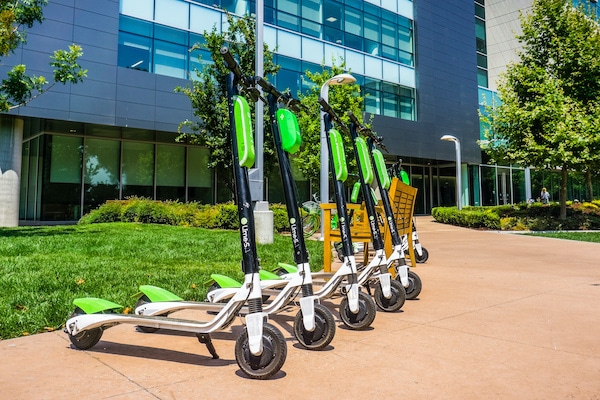Metropolitan areas are hubs for innovative ideas that aim to change the way people think about transportation. Buses, trains, carpool lanes, and bikes were only the beginning.
Electric scooter companies are emerging onto the scene, hoping to further revolutionize the urban transportation industry. And these companies, choosing to be dockless as a savvy business move, are providing opportunities for people looking to earn some extra cash by charging them.
But how much can you really earn charging scooters?
Surprisingly, you can earn anywhere from $5-$500 per night, depending on how many scooters you pick up to charge and assuming the market isn’t over-saturated. Plus, if you return them to their “nests” on time, you can get paid via direct deposit that same day!
But before you start rushing to sign up, let’s take a closer look to see what these companies are all about, how you get signed up, what the dangers could be, and if it’s worth it.
What Scooters Are We Talking About?
If you live in an urban area, you’re probably already familiar with this new type of transportation, but if you live in a rural setting, you might be confused.
To clarify, we are talking about electric scooters that you can rent to travel around a city. You pick them up at point A, and drop them off at point B whenever you’re done.
There’s a strong debate as to whether or not this concept is revolutionizing the transportation industry, but two main companies are leading the charge: Lime (formerly LimeBike) and Bird.

Lime has multiple locations across the U.S. – mostly along the coasts – as well as a few major hubs in Europe, Canada, Australia, South America, and even the Middle East. Bird has similar locations as well.

The scooter companies have apps that correlate with a GPS tracking system so riders can know where they’re going and how much battery life they have left. Bird even has a program that lets the city track where the devices are.
These scooters are dockless, meaning that there aren’t any charging ports around the city for people to leave the scooters to recharge. While that is a smart business move on behalf of the company – because they don’t have to pay to install and keep up any of them – it’s also good news for you.
Why? Because they’ll pay you to take them home, charge them, and drop them off at a “nest” when you’re done.
How Do They Make Money?
The mission behind the concept is easy to deduce: lower emissions, help the environment, and transform the way people commute in metropolitan areas. However, as a business, they’re also in it for money. So, how do they make it?
It’s simple: users pay the companies to use their scooters.
To rent a scooter from Lime, for example, costs $0.15 per minute plus an unlocking fee of $1. So, if you were to go on a 30-minute ride, that would be about $4.50.
The company Bird reports making around $11 per day per scooter in the Santa Monica area. And in a city like San Francisco, Lime earns around $20 per day per scooter.
How To Make Money Charging Scooters
So, how exactly does this process work? Well, we’re going to take a look at how to become a charger for the company Bird specifically, but Lime’s process is very similar.
All you have to do is follow these steps:
- Sign up
- Collect scooters and charge them
- Get paid
1. Sign Up
The sign-up process is easy and can be done either through Bird’s website or through their app. All you do is find where it says “Become a Charger,” click on it, and begin the process.
The application asks for standard information, like your name, email, and phone number.
After it’s been submitted, you’ll have to wait to hear back from the company. If your application is accepted, you’ll be asked to do an interview over the phone.
They’ll be looking for information like how many scooters you’ll charge per night and what type of vehicle you will be collecting the scooters in.
If all goes well, then you’ll be accepted and ready for the next step!
2. Collect scooters and charge them
Once you’ve been accepted, Bird will provide you with an adapter for charging their scooters. If you want to be able to charge more, you can purchase more adapters on Amazon.
There is a limit on how many you can charge per day, but it varies person-to-person.
Since people can drop off and lock the scooters anywhere, you’ll need to locate them using the app.
The app will give you the location of the scooter and it will tell you how much that scooter will pay. There’s a QR code on the scooter that you can scan which will release it so you can take it home and charge it.
You can pick up scooters at any time of the day, but Bird recommends collecting after 9:00 p.m., because it’s after their peak hours.
Once they’ve been charged, you bring them back to an assigned “nest” by 7:00 a.m. the following morning. You’ll need to scan the QR code again to release it, and you’ll have to take a photo of it in the nest in order for it to technically be complete.
It’s worth taking into consideration that each scooter weighs from 25-35 pounds, and Bird’s scooters don’t fold (although some other companies’ do). So, the bigger your vehicle is, the easier it will be to carry more home.
3. Get paid
The last step is to get paid, which is done through direct deposit to the account you provided during the sign-up process.
In order to receive full payment, you must return scooters with at least 95% charge before 7:00 a.m. If you release the scooter after that, you risk a 50% reduction in your payment.
One cool thing is that, if your scooters are returned on time, you’ll get paid the same day.
How Much Can You Make?
How much you can earn depends on how many scooters you charge per night and what the value of the scooters is.
When looking on the app for the available scooters for pickup, it will tell you how much they’ll pay. All scooters have a base value of $5 per charge and can go all the way up to $25, depending on the difficulty of pickup.
Things that count as a “difficult pickup” are scooters that may be behind a fence, on private property, or otherwise really far away.
So, to put that into perspective, if you picked up 20 scooters a night (there are some people who collect 40 or more) you would be making $100 a night – if they were only $5 apiece. If they were all $25 apiece, you could make $500 a night, which is significantly more than most other side gig opportunities.
Are There Startup Costs?
The only potential genuine up front cost would be if you decided to purchase more adapters. They run about $25 on Amazon, and they’ll allow you the capacity to charge more scooters at once.
Other cost factors are gas and electricity. The cost of gas depends on where you’re going to pick them up from, and the efficiency of your vehicle.
And while electricity might seem like a lot, Bird states that on average it only costs between $0.08-$0.25 to fully charge a vehicle. The electricity rates in your area will, of course, influence that.
The Dangers Of Charging Scooters
Like dumpster diving, there is a hidden aspect that needs to be addressed: the danger.
While some Bird chargers complain that the map the app provides to locate the scooters isn’t always accurate, there’s a bigger threat lurking around the corner.
For one, because some areas are oversaturated, there have been reports of altercations amongst fellow chargers who are arguing over a specific scooter. But that’s not the worst of it.
There have actually been reports of people purposefully placing a scooter in a specific place to lure chargers to bad areas with the intent of robbing them, or worse. Some chargers even report carrying around pepper spray because of things that have happened.
This danger is exacerbated by the fact that these companies operate in urban areas and encourage people to collect between 9:00 p.m. and 7:00 a.m. – when both aggravated and sexual assaults are more likely to occur.
Things I Like
- Have the potential to earn a lot
- Has low startup costs
- Has lots of locations around the world
- Can get paid the same day
Things I Don’t Like
- Limited to major urban areas
- Can be dangerous
- Over-saturated markets can mean less income potential
- GPS isn’t always accurate
Conclusion
All-in-all, charging scooters can be a lucrative side gig, but it comes with its fair share of risks.
It’s easy to get started, has low upfront costs, and can bring in a decent profit. However, it can be dangerous (no amount of money is worth your safety), and over-saturated markets can lower your chances of earning big.


Please note: By submitting a comment using the above comment form, you confirm that you agree with the storage and handling of your data by this site as detailed in our Privacy Policy.